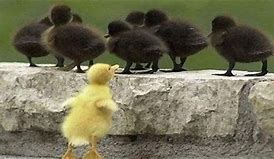Assignment Takeaway
ATA5
Assignment five was all about doing acts of kindness for other people, and right about now I think that little acts of kindness are in short supply. As far as assignments go, this one was particularly easy because it’s just doing nice things for people, something most of us do all the time. The important part, in my opinion, was seeing how people (including us) reacted to the good deeds. My takeaway is that, regardless of how a person may react to something nice you do for them, we can be draw some intrinsic satisfaction from the action itself.
A connection that could be made would be to look at who we did our acts of kindness for and if they would be considered members of our in-group or not. Were we doing nice things for people “like us” in some way or were we indiscriminate in our kindness? The picture below is just a visual representation of one type of definition of an in-group vs. an out-group, in this case the yellow chick is the out-group compared to the black or brown chicks.

ATA4
The biggest takeaway I got from assignment four where we looked at the styles of love is that I am not the most outwardly loving person. After the assignment and the styles of love test that we took, I had my girlfriend take it and compared her results to the average for women. Without going into too much detail, she scored lower (so higher in amount of love) in every single category save for ludus than both me and the average woman tested. Doing this assignment made me realize some things about myself that I’d never really thought about before it; I never realized that my sense and expression of love was so, deficient for lack of a better word, compared to other men.
I think that doing this assignment has helped me realize that what I think is an acceptable amount of affection isn’t necessarily what someone else would think is enough. I chose this picture because I think it pretty much embodies how my relationships have been in the past. I’ve always assumed that everyone treats love and affection the same way that I did and I don’t think I did enough to express my feelings to partners I’ve had.

ATA3
In assignment three, we had to watch a rant by Michael Richards where he called some hecklers at a stand-up show various racial slurs and insinuated that they would be lynched etc. The point was to try and determine if he used those words and phrases out of anger or a deep-seated belief that whites are the superior race. I think a takeaway from the assignment that I have is that regardless of how the slurs are delivered, the point of the slurs is to hurt others. Slurs and racial epithets are created by hatred, and when we invoke them, we bring all the hate that created them to bear onto our victims, and because of this I decided that even if Richards was just angry at them, by using these words he showed a racist side of himself.
As I said in the assignment, I believe the only acceptable time to use these words is when they are integral to a piece of literature that was written when the terms were commonplace. To this end I chose to include an image of The Adventures of Huckleberry Finn, a book that I’m sure most of us were required to read at some point in our school careers. I believe that the slur placed in front of Jim is meant to show how pervasive the term, and racism itself, was during the time the novel takes place. The point of the novel is freedom and the different meanings freedom can have based on personal circumstance, and by hammering home Jim’s status as a slave or the Other, Twain could define his idea of freedom, in this case a literal freedom from slavery. This represents what I would say is the only circumstance in which it is acceptable to use these terms.

ATA1
Our first assignment showed how heuristics can be a double-edged sword. We learned how we try and fit people or situations to schemas in our heads on first impression, and how sometimes we think things are more prevalent or worse than they actually are because they come to mind more quickly or strongly. Personally, I fall victim to the availability heuristic because I believe that sinus infections are much more common than they actually are due to the fact that I end up getting one several times a year (in addition to several family members). Because they happen to me and I can remember them easily, my perception of their prevalence is skewed to believe they’re more common than they are.
In some of my computer science classes, I learned about fast-and-frugal trees which are just basically flow charts for decision making that even a computer can use. The good thing about them is that they’re incredibly simple and easy to use; every choice is binary, with one choice exiting the chart and the other leading to another binary question. This makes computing incredibly simple, but it has the effect of uncertainty in that you don’t know how many steps through this chart that you’ll need to exit. Fast-and frugal trees are quick and easy, but they’re inefficient when faced with complex information and show that to make good decisions we need to gather more than surface layer information. Below is an example of a fast-and-frugal chart to determine where to send a patient complaining of chest pain. You can see the binary choices with each choice providing either an answer or a step to the next choice.

